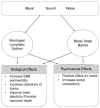Effects of Sound Interventions on the Permeability of the Blood-Brain Barrier and Meningeal Lymphatic Clearance
- PMID: 35741627
- PMCID: PMC9221168
- DOI: 10.3390/brainsci12060742
Effects of Sound Interventions on the Permeability of the Blood-Brain Barrier and Meningeal Lymphatic Clearance
Abstract
The meningeal lymphatic, or glymphatic, system is receiving increasing attention from the scientific community. Recent work includes noninvasive techniques to demonstrate relationships between blood-brain barrier (BBB) activity and the glymphatic system in the human central nervous system. One potential technique is the use of music/sound to enhance BBB permeability regarding the movement of small molecules in and out of the brain. However, there is minimal knowledge regarding the methodical investigation(s) of the uses of music/sound on BBB permeability and glymphatic clearance and the outcomes of these investigation(s). This review contains evidence discussing relationships between music/sound, BBB permeability, and meningeal lymphatic clearance. An overview of the anatomy and physiology of the system is presented. We discuss the uses of music/sound to modulate brain and body functions, highlighting music's effects on mood and autonomic, cognitive, and neuronal function. We also propose implications for follow-up work. The results showed that music and sound interventions do, in fact, contribute to the opening of the BBB and subsequently increase the function of the meningeal lymphatic system. Evidence also suggests that music/sound has the ability to reduce the collateral effects of brain injuries. Unfortunately, music/sound is rarely used in the clinical setting as a medical intervention. Still, recent research shows the potential positive impacts that music/sound could have on various organ systems.
Keywords: elimination; glymphatic system; meninges; music; noise; opening.
Conflict of interest statement
The authors declare no conflict of interest. The funders had no role in the study’s design, in the collection, analyses, or interpretation of data, in the writing of the manuscript, or in the decision to publish the results.
Figures


Similar articles
-
Can Immersive Sound Therapy Counteract Neurodegeneration by Enhancing Glymphatic Clearance? Comment on Sachdeva et al. Effects of Sound Interventions on the Permeability of the Blood-Brain Barrier and Meningeal Lymphatic Clearance. Brain Sci. 2022, 12, 742.Brain Sci. 2023 Jan 4;13(1):98. doi: 10.3390/brainsci13010098. Brain Sci. 2023. PMID: 36672079 Free PMC article.
-
Application of optical coherence tomography for in vivo monitoring of the meningeal lymphatic vessels during opening of blood-brain barrier: mechanisms of brain clearing.J Biomed Opt. 2017 Dec;22(12):1-9. doi: 10.1117/1.JBO.22.12.121719. J Biomed Opt. 2017. PMID: 29275545 Free PMC article.
-
The Underlying Role of the Glymphatic System and Meningeal Lymphatic Vessels in Cerebral Small Vessel Disease.Biomolecules. 2022 May 25;12(6):748. doi: 10.3390/biom12060748. Biomolecules. 2022. PMID: 35740873 Free PMC article. Review.
-
Drug delivery pathways to the central nervous system via the brain glymphatic system circumventing the blood-brain barrier.Exploration (Beijing). 2024 Jul 9;5(2):20240036. doi: 10.1002/EXP.20240036. eCollection 2025 Apr. Exploration (Beijing). 2024. PMID: 40395758 Free PMC article. Review.
-
Photobiomodulation Therapy and the Glymphatic System: Promising Applications for Augmenting the Brain Lymphatic Drainage System.Int J Mol Sci. 2022 Mar 10;23(6):2975. doi: 10.3390/ijms23062975. Int J Mol Sci. 2022. PMID: 35328396 Free PMC article. Review.
Cited by
-
Emerging Roles of Meningeal Lymphatic Vessels in Alzheimer's Disease.J Alzheimers Dis. 2023;94(s1):S355-S366. doi: 10.3233/JAD-221016. J Alzheimers Dis. 2023. PMID: 36683509 Free PMC article. Review.
-
Efficacy of music therapy as a non-pharmacological measure to support alzheimer's disease patients: a systematic review.BMC Geriatr. 2025 Jul 8;25(1):508. doi: 10.1186/s12877-025-06073-7. BMC Geriatr. 2025. PMID: 40629265 Free PMC article.
-
Meningeal lymphatic drainage: novel insights into central nervous system disease.Signal Transduct Target Ther. 2025 May 5;10(1):142. doi: 10.1038/s41392-025-02177-z. Signal Transduct Target Ther. 2025. PMID: 40320416 Free PMC article. Review.
-
Current Update on Transcellular Brain Drug Delivery.Pharmaceutics. 2022 Dec 5;14(12):2719. doi: 10.3390/pharmaceutics14122719. Pharmaceutics. 2022. PMID: 36559214 Free PMC article. Review.
-
The glymphatic system's role in traumatic brain injury-related neurodegeneration.Mol Psychiatry. 2023 Jul;28(7):2707-2715. doi: 10.1038/s41380-023-02070-7. Epub 2023 Apr 25. Mol Psychiatry. 2023. PMID: 37185960 Review.
References
Publication types
Grants and funding
LinkOut - more resources
Full Text Sources

